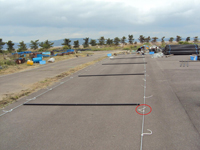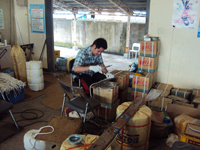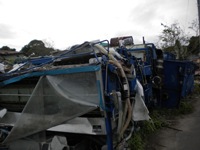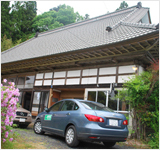2011.07.01 11:37
Volunteer report: 1 July 2011 vol.2 - Katsurashiima, Urato Islands -
Details of activity:Helping the fishermen who cultivate seaweed (Shearing ropes used for rafts)
-------------------------------------------------------------------------------------
(Mr. A ・Age:26 ・ Male Tokyo resident)
What I felt when I came into contact with the people at the site is that they are all have a positive outlook. Everything they had spent their time and effort on until now has all fallen apart and there is no other way but to start building their lives again from scratch. Electricity only started coming through at the beginning of May, and there being no hospital, the island residents told us warmly how grateful they were for us to come week after week to volunteer.
I felt strongly that despite being in difficult circumstances, in order to be able to live alongside the beautiful sea again, it is necessary to recognize what needs to be done and carry it out. When living in urban areas there is always a tendency to have sparse interaction with neighbours, but in Katsurajima the whole town is like one big family, and regardless of the fact that there was a huge earthquake disaster it felt steeped in a warm atmosphere.
2011.07.01 11:37 admin











 Despite the fact that 850 rafts are to be made by the time seeds need to be attached for seaweed cultivation in autumn, only 300-400 rafts have been completed. Although the work was simple, involving cutting ropes for net spreading to a fixed length using a soldering iron, it was a great help for the small number of fishermen for us to lend our hand with this activity.
Despite the fact that 850 rafts are to be made by the time seeds need to be attached for seaweed cultivation in autumn, only 300-400 rafts have been completed. Although the work was simple, involving cutting ropes for net spreading to a fixed length using a soldering iron, it was a great help for the small number of fishermen for us to lend our hand with this activity.
 At times other than when seaweed is being cultivated, gathering clams and wakame seaweed makes up a crucial part of the fishermen's livelihoods. However, land subsidence due to the recent earthquake disaster has resulted in a rise in the water level and we heard that it is no longer possible for them to gather clams.
At times other than when seaweed is being cultivated, gathering clams and wakame seaweed makes up a crucial part of the fishermen's livelihoods. However, land subsidence due to the recent earthquake disaster has resulted in a rise in the water level and we heard that it is no longer possible for them to gather clams. Seaweed drying machines (see photo) belonging to five fishermen were washed away by the tsunami. With one machine costing around 40 million yen, it is difficult to invest in new equipment, so they have decided to have joint use of the five drying machines that remain.
Seaweed drying machines (see photo) belonging to five fishermen were washed away by the tsunami. With one machine costing around 40 million yen, it is difficult to invest in new equipment, so they have decided to have joint use of the five drying machines that remain.
